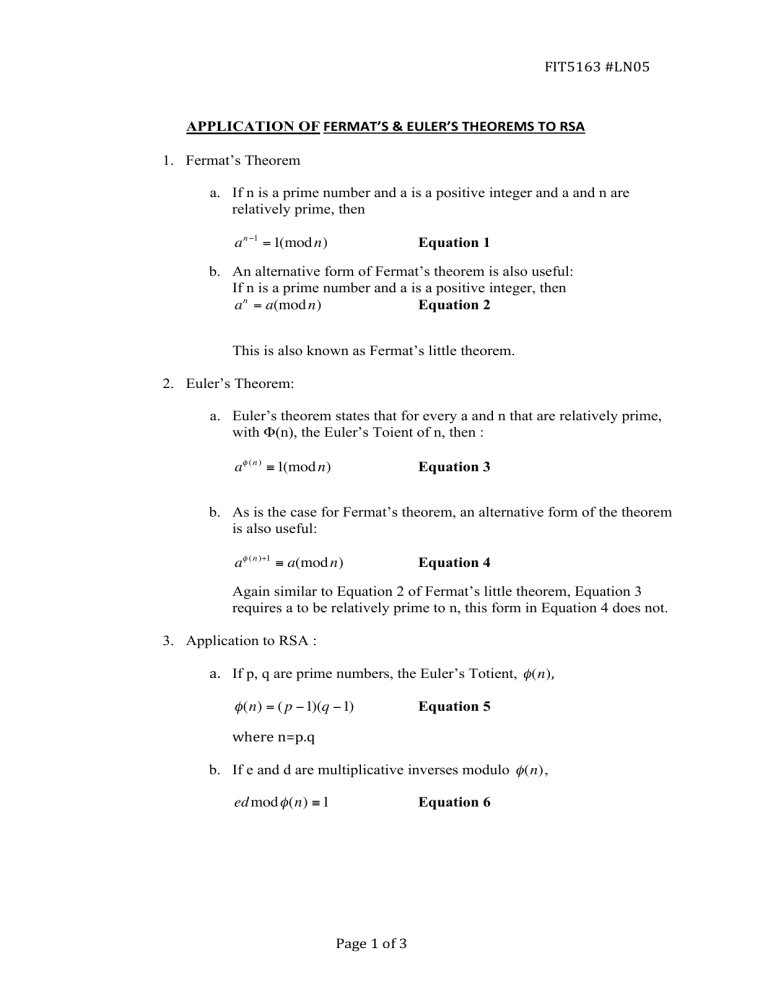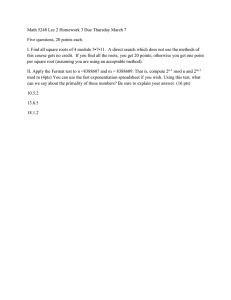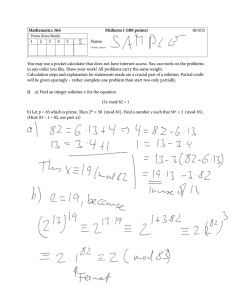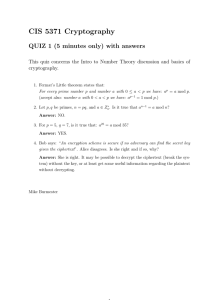
FIT5163 #LN05 APPLICATION OF FERMAT’S & EULER’S THEOREMS TO RSA 1. Fermat’s Theorem a. If n is a prime number and a is a positive integer and a and n are relatively prime, then a n −1 = 1(mod n) € Equation 1 b. An alternative form of Fermat’s theorem is also useful: If n is a prime number and a is a positive integer, then Equation 2 a n = a(mod n) This is also known as Fermat’s little theorem. € 2. Euler’s Theorem: a. Euler’s theorem states that for every a and n that are relatively prime, with Φ(n), the Euler’s Toient of n, then : aφ (n ) ≡ 1(mod n) € Equation 3 b. As is the case for Fermat’s theorem, an alternative form of the theorem is also useful: aφ (n )÷1 ≡ a(mod n) Equation 4 Again similar to Equation 2 of Fermat’s little theorem, Equation 3 requires a to be relatively prime to n, this form in Equation 4 does not. € 3. Application to RSA : a. If p, q are prime numbers, the Euler’s Totient, φ (n), φ (n) = ( p −1)(q −1) where n=p.q € Equation 5 € b. If e and d are multiplicative inverses modulo φ (n), Equation 6 ed mod φ (n) ≡ 1 € € Page 1 of 3 FIT5163 #LN05 Another way to state this is: Equation 7 ed = kφ (n) +1 € c. Given primes p and q with n = pq and a message block M< n, e and d are chosen to be multiplicative inverse modulo φ (n), as per in Equation 6 and 7, we can say that, M ed mod n = M kφ (n )+1 mod n = M k( p −1)(q −1)+1 mod n Equation 8 € First we shall show that: € M k( p −1)(q −1)+1 mod p = M mod p Case 1: M and p are not relatively prime; that is p divides M. In this case, M mod p = 0 and there fore, € € € Equation 9 M k( p −1)(q −1)+1 mod p = 0 Equation 10 Thus M k( p −1)(q −1)+1 mod p = M mod p; Equation 11 Case 2: M and p are relatively prime, by Euler’s Theorem, Equation 3 above, M φ ( p ) mod p = 1; € We proceed as follows: € M k( p −1)(q −1)+1 mod p = [(M)M ( p −1)k(q −1) ]mod p = [(M)(M ( p −1) ) k(q −1) ]mod p = [(M)(M φ ( p ) ) k(q −1) ]mod p = (M mod p) × [(M φ ( p ) )mod p]k(q −1) Equation 12 = (M mod p) × (1) k(q −1) (byEuler' sTheorem) = M mod p We now observe that € [M k( p −1)(q −1)+1 − M]mod p = [M k( p −1)(q −1)+1 mod p] − [M mod p] = 0 Equation 13 € Page 2 of 3 FIT5163 #LN05 Thus p divides [M k( p −1)(q −1)+1 − M] . By the same reasoning we can show that q divides [M k( p −1)(q −1)+1 − M] . Because p and q are distinct primes, there must exist an integer r that satisfies −1)(q −1)+1 − M] = ( pq)r = nr [M k( p € € Equation 14 There fore, n divides [M k( p −1)(q −1)+1 − M] , and so, € M kφ (n )+1 mod n = M k( p −1)(q −1)+1 mod n = M € M < n. for any message € Page 3 of 3 Equation 15







